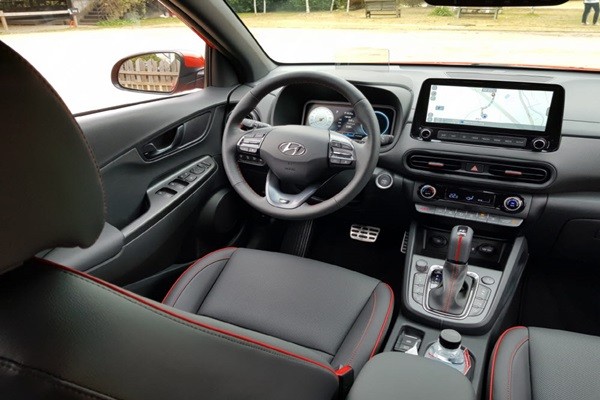All new Hyundai Motor Company’s Kona N line has given a strong first impression. Although the body is small, it has excellent performance due to partial modification. It is able to reach a desirable speed in just few seconds and provides an agile movement when its steering wheel is turned and stable suspension at the same time. It is also equipped with a heads-up display (HUD) and high-tech ADAS (Advanced Driver Assistance Systems).
Kona is a small SUV launched by Hyundai Motor Company back in 2017. Since then, derivative models such as “Kona Electric” and “Kona Hybrid” were launched in April of 2018 and September of 2019 respectively. The company added another model “N line” by launching the car’s first partially changed model. Out of SUVs that are available in South Korea, Kona is the first to be added with a N line.
The Electronic Times test drove the new Kona N line with Inspiration trim and full options and “Ignite Flame” color. The test drive started at Hyundai Motor Studio in Goyang to Hesse’s Garden and back to the studio.
The N line along with the company’s N models form the company’s high-performance sub-brand “Hyundai N”. The N line comes with high-performance automotive parts such as brake and suspension and it has more agile movement than basic models due to sensitive tuning of steering wheel and suspension.

Once driving mode of the new Kona is switched to “sports” mode, one is able to maximize the strength of the car’s engine. Although the car may be small, there was no limitation in high-speed driving. The car was able to reach 100km/h in just few seconds and higher speeds with no issue due to its maximum horsepower of 198 and maximum torque of 27 kilogram per meter.
The car provided stability even during cornering and lane change. Its steering wheel reacted quickly to handling, and its rolling was stable as well. Its suspension absorbed impact from roads adequately, and there was no noise from the roads due to the car’s excellent sound insulation materials. However, there was wind noise that was coming through the windows during a high-speed driving. Wind noise can be offset by raising music volume.
The car comes with Eco, Normal, Sports, and Smart modes. Its mileages for the Sports mode and the Eco mode were 10.9km/l and 16.1km/l respectively. Its official mileage is 11.6km/l based on combined mileage, and it showed an adequate mileage during the test drive. This is the result of Hyundai Motor Company’s effort to improve the car’s mileage while increasing its horsepower at the same time.
HUD and ADAS were also very effective during the test drive. The car’s HUD is a combiner glass HUD that utilizes a separate reflective screen rather than the windshield. Although combiner glass HUD looks less neat from a design aspect than windshield-type HUD, having a HUD is a huge advantage for a small SUV. One does not have to worry about making wrong turns as he or she is able to check the navigation at the right time through the car’s HUD. Its HUD also gave warnings when other cars were approaching the car by utilizing radars that are located at the front and the back of the car and front camera.

The car’s semi self-driving ability was useful when it was not easy to pass other cars due to the number of cars that were on the road. One does not have to step on the accelerator by utilizing LFA (Lane Following Assist) and SCC (Smart Cruise Control) functions and just pay attention the front while holding onto the steering wheel and press the brake when necessary. The car did not slow down rapidly even when other cars cut in and provided a high level of technology completion compared to other brands.
The inside was also equipped with smart components. The dashboard became digital while the infotainment system display became much bigger from 2.5 inches to 10.25 inches. Although the wireless charging space for smartphones was located under the center fascia and was reachable from the driver’s seat, there was a good distance between the space and the driver’s seat.
The new Kona N line’s design is also different from other basic Kona models. First, Hyundai’s emblem along with a N line emblem are located on top of the radiator grille rather than the hood line. There is also a N line emblem at the side of the car. The car’s radiator grille is a mesh design that is exclusively for the N line while the bumpers display a sporty design that emphasizes air curtain.
Besides these changes, the car’s 18-inch alloy wheels that are exclusive for the N line, LED head lamps with black bezel, gear knob with a N emblem, and seats that have red edges and N emblems separate the new Kona from other basic models.
Although the new Kona provides satisfactions in running performance and design, it has limitations when it comes to the space. Although the car’s length became 40mm longer, there was not much improvement in utilizing empty space. Only the space between the front seats and the back seats became little bit more spacious. Although the trunk size also increased by 10 liters, trunk door has to be open if an adult wants to lie flat with legs stretched out. One has to consider the car’s dimension if he or she is a person who enjoys car camping.
The new Kona comes with various selections as it is available in ten different exterior colors and five different interior colors. Ignite Flame, Galactic Gray, Cyber Gray, Surf Blue, Dive in Jeju, and Misty Jungle were added as new exterior colors.
1.6 turbo N line model also comes with the “Modern” trim in addition to the “Inspiration” trim that is the highest trim. Prices for the Modern and the Inspiration trim are $21,700 (24.6 million KRW) and $24,900 (28.14 million KRW) respectively. The full-option model costs $28,300 (32.08 million KRW).
Staff Reporter Park, Jinhyeong | jin@etnews.com